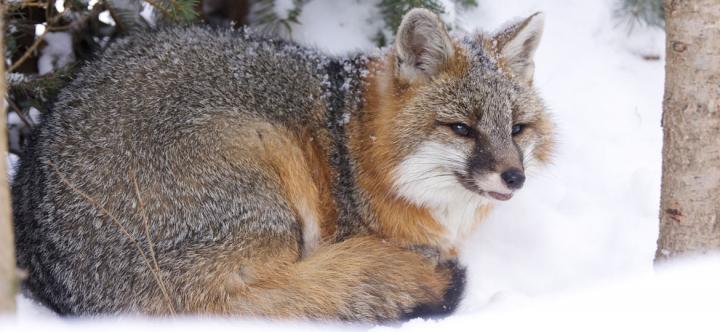Virus highly contagious to domesticated dogs

Credit: Vermont Fish and Wildlife Department
DURHAM, N.H.–A distinct strain of canine distemper virus, which is a widespread virus of importance to wildlife and domesticated dogs, has been identified in wild animals in New Hampshire and Vermont, according to pathologists with the New Hampshire Veterinary Diagnostic Lab at the University of New Hampshire. No virus in this distinct subgroup of canine distemper virus has yet been reported in a domesticated dog.
“A distinct strain of canine distemper virus is circulating in multiple wildlife species in two contiguous states in Northern New England,” said David Needle, senior veterinary pathologist and assistant clinical professor. “This strain is significantly distinct from the vaccine strains. A member of genus Morbillivirus that includes measles, canine distemper virus is highly contagious and causes severe disease in infected animals.”
The new strain of canine distemper virus was identified by UNH pathologists in collaboration with colleagues at Cornell University, University of Georgia, Northeast Wildlife Disease Cooperative, N.H. Fish and Game, and Vermont Fish and Game. Over a one-year period, pathologists diagnosed canine distemper virus infection in eight largely carnivorous mammals in southeastern New Hampshire and north central Vermont. The animals included three fishers, two gray foxes, one skunk, one raccoon, and one mink.
Pathologists found all animals were infected with a distinct strain of the virus that had been identified only in a single raccoon in Rhode Island in 2004, which was not described in any publication. The eight animal cases also represent the only reports of any canine distemper virus isolated from New Hampshire and Vermont in the GenBank database/.
“This can and may already be having an impact on the population of wild mesocarnivores in New Hampshire and New England,” said Needle. “These animals are an integral part of the varied ecosystems of wild New Hampshire and New England, filling important niches in predator-prey relationships and pest control. Any decrease in wildlife populations is a loss to the rich wild diversity. The affected species also are furbearing mammals that serve as part of the cultural heritage of the northern sportsman.”
Canine distemper virus vaccination is part of the core vaccine protocols for domesticated dogs. All dogs should be vaccinated routinely. Canine distemper virus infection in dogs is most often characterized by respiratory disease, oral and nasal discharge, gastroenteritis, and as the disease progresses, neurological disease. This is a severe, highly pathogenic and highly contagious disease, so any suspected infection should be reported immediately to a veterinarian. Any unvaccinated animals should be vaccinated.
The results of this case are presented in the Journal of Veterinary Diagnostic Investigation. The research is supported by the New Hampshire Agricultural Experiment Station and the State of New Hampshire.
The New Hampshire Veterinary Diagnostic Lab is co-managed by the New Hampshire Department of Agriculture, Markets & Food and the New Hampshire Agricultural Experiment Station. Since 1970, the lab has provided accessible, timely and accurate diagnostic services for the New Hampshire Department of Agriculture, Markets, & Food, New Hampshire Department of Health and Human Services, New Hampshire Fish and Game Department, state and local law enforcement agencies, veterinarians, farmers, state, regional, and federal agencies, and individuals.
The University of New Hampshire inspires innovation and transforms lives in our state, nation and world. More than 16,000 students from all 50 states and 71 countries engage with an award-winning faculty in top-ranked programs in business, engineering, law, health and human services, liberal arts and the sciences across more than 200 programs of study. As one of the nation’s highest-performing research universities, UNH partners with NASA, NOAA, NSF and NIH, and receives more than $110 million in competitive external funding every year to further explore and define the frontiers of land, sea and space.
###
PHOTO FOR DOWNLOAD:
https:/
The new strain of canine distemper virus was found in two gray foxes similar to these foxes. Credit: Vermont Fish and Wildlife Department.
Media Contact
Lori Wright
[email protected]
Original Source
https:/
Related Journal Article
http://dx.




